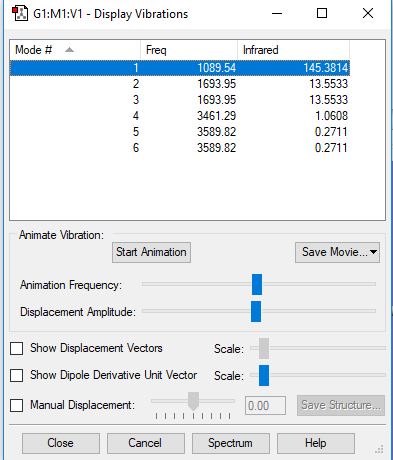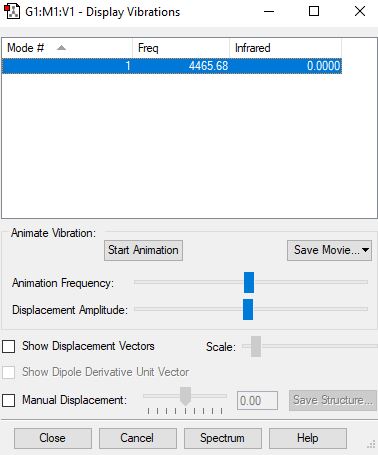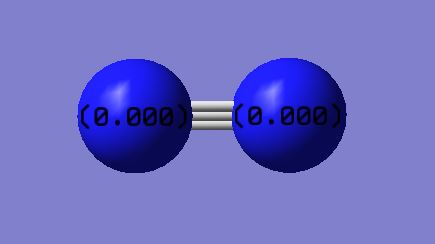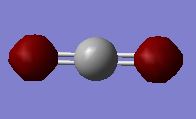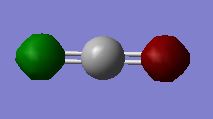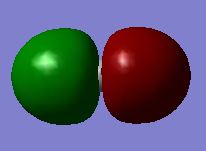Mod01493832
NH3 Molecule
Summary information:
The calculation method used for the optimised structure is RB3LYP.
The basis set is 6-31G(d,p).
The final energy E(RB3LYP) is -56.56 a.u. (to 2 d.p.)
The RMS gradient is 0.00000485 a.u.
The point group of NH3 is C3V.
The optimised N-H bond length is 1.020 Å while the optimised H-N-H bond angle is 106°.
Item Table
To ensure that the structure obtained have fully optimised, a table has been included below:
| Item | Value | Threshold | Converges? |
|---|---|---|---|
| Maximum Force | 0.000004 | 0.000450 | YES |
| RMS Force | 0.000004 | 0.000300 | YES |
| Maximum Displacement | 0.000072 | 0.001800 | YES |
| RMS Displacement | 0.000035 | 0.001200 | YES |
Jmol Dynamic Image
NH3 |
Molecule Vibrations
Vibration of NH3 Molecule
| wavenumber (cm-1) | 1090 | 1694 | 3461 | 3590 |
| symmetry | A1 | E | A1 | E |
| intensity (arbitrary units) | 145 | 14 | 1 | 0 |
The number of expected vibrational modes from 3N-6 rule is 6, there are 2 pairs of vibrations that are degenerate. These ones are 1693.9474 and 3589.8170 cm-1. In general, the bonds bend at lower wavenumber and stretch at higher wavenumber. Wavenumber 1089.54 and 1693.95 cm-1 are 'bending' vibrations while 3461.29 and 3589.82 cm-1 are 'bond stretch' vibrations. The first vibrational mode in the table shown above is the 'umbrella' mode which occurs at 1089.54 cm-1. The vibration at 3461.29 cm-1 is highly symmetrical. Ammonia is expected to show 3 bands in an experimental spectrum, this is because the symmetrical and asymmetrical stretch at 3461.29 cm-1 and 3589.82 cm-1 will overlap resulting in a broad peak. The other two bands will be at 1089.54 cm-1 and 1693.95 cm-1.
Atomic Charge
N is expected to have a negative charge value because it is more electronegative than H meaning it will pull the N-H bonding electrons toward itself resulting in an overall negative charge around the N. This causes H to have a positive charge around it and the prediction is correlated with the calculated atomic charge shown below.
H2 Molecule
Summary information:
The calculation method used for the optimised structure is RB3LYP.
The basis set is 6-31G(d,p).
The final energy E(RB3LYP) is -1.18 a.u. (to 2 d.p.)
The RMS gradient is 0.00000017 a.u.
The point group of H2 is D∞H.
The optimised H-H bond length is 0.743 Å while the optimised H-H bond angle is 180°.
Item Table
To ensure that the structure obtained have fully optimised, a table has been included below:
| Item | Value | Threshold | Converges? |
|---|---|---|---|
| Maximum Force | 0.000000 | 0.000450 | YES |
| RMS Force | 0.000000 | 0.000300 | YES |
| Maximum Displacement | 0.000000 | 0.001800 | YES |
| RMS Displacement | 0.000001 | 0.001200 | YES |
Jmol Dynamic Image
H2 |
Molecule Vibration
The molecule H2 does not have a change in dipole, therefore it is considered IR inactive, the intensity of IR absorption at 4466 cm-1 is 0 arbitrary units.
Atomic Charges
Because H2 is a diatomic molecule, the charge on each H atom is 0.00 (neutral).
N2 Molecule
Summary information:
The calculation method used for the optimised structure is RB3LYP.
The basis set is 6-31G(d,p).
The final energy E(RB3LYP) is -109.52 a.u. (to 2 d.p.)
The RMS gradient is 0.00000060 a.u.
The point group of N2 is D∞H.
The optimised N triple bond length is 1.11 Å while the optimised triple bond angle is 180°.
Item Table
To ensure that the structure obtained have fully optimised, a table has been included below:
| Item | Value | Threshold | Converges? |
|---|---|---|---|
| Maximum Force | 0.000001 | 0.000450 | YES |
| RMS Force | 0.000001 | 0.000300 | YES |
| Maximum Displacement | 0.000000 | 0.001800 | YES |
| RMS Displacement | 0.000000 | 0.001200 | YES |
Jmol Dynamic Image
N2 |
Molecule Vibration
The molecule N2 does not have a change in dipole, therefore it is considered IR inactive, the intensity of IR absorption at 2457 cm-1 is 0 arbitrary units.
Atomic Charge
Because N2 is a diatomic molecule, the charge on each N atom is 0.00 (neutral).
Mono Metallic TM Complex
The transition metal complex containing N2 is trans-bis(dinitrogen)-bis(N,N-bis((diphenylphosphino)methyl)methanamine)-molybdenum, which has the structure ZAVJOX and both N-N bond lengths are 1.094(3)Å, whereas the reported bond length above is 1.11 Å. The difference is that one of them is bonded to a transition metal centre meaning the experimental value takes into consideration the stabilisation through orbital overlaps (N and transition metal). The computational value through optimisation is only for N-N bond, no stabilising effect and so the N-N bond in the complex is shorter and stronger.
The Haber-Bosch process
For the reaction N2 + 3H2 -> 2NH3, the energy can be calculate as following:
E(NH3)= -56.5577687 a.u.
2*E(NH3)= -113.1155375 a.u.
E(N2)= -109.5241287 a.u.
E(H2)= -1.17853936 a.u.
3*E(H2)= -3.5356181 a.u.
ΔE= 2*E(NH3)-[E(N2)+3*E(H2)] = (-113.1155375) + 109.5241287 +3.5356181 = - 0.0557907 a.u. (which is equivalent to - 146.8 kJ/mol)
Because ΔE is negative, it can be concluded that the ammonia product is more stable.
CO2
Summary information:
The calculation method used for the optimised structure is RB3LYP.
The basis set is 6-31G(d,p).
The final energy E(RB3LYP) is -188.58 a.u. (to 2 d.p.)
The RMS gradient is 0.00001154 a.u.
The point group of CO2 is D∞H.
The optimised C=O bond length is 0.743 Å while the optimised C=O bond angle is 180°.
Item Table
To ensure that the structure obtained have fully optimised, a table has been included below:
| Item | Value | Threshold | Converges? |
|---|---|---|---|
| Maximum Force | 0.000024 | 0.000450 | YES |
| RMS Force | 0.000017 | 0.000300 | YES |
| Maximum Displacement | 0.000021 | 0.001800 | YES |
| RMS Displacement | 0.000015 | 0.001200 | YES |
Jmol Dynamic Image
CO2 |
Molecule Vibration
Vibration of CO2 Molecule
| wavenumber (cm-1) | 640 | 1372 | 2436 |
| intensity (arbitrary units) | 31 | 0 | 546 |
CO2 is expected to show 3 bands in the IR spectrum, the vibration at 640 cm-1 is degenerate and is a bending frequency where as the ones at 1372 and 2436 cm-1 are the stretching frequencies.
Atomic Charge
Oxygen is more electronegative than Carbon (EN: 3.44 and 2.55 respectively), therefore Oxygen pulls the bonding C=O electrons toward itself and thus, results in a more positive charge distribution on the Carbon.
Molecular Orbitals
This is a combination of ,fully occupied, 1s AOs which is very deep in energy (-19.24 a.u.) and barely contributes to the bonding MOs.
This is a combination of 1s antibonding orbitals which is also very deep in energy (-19.24 a.u.) and barely contributes to the bonding MOs because the energy gap is large with respect to other atomic orbitals so they do not overlap at at all and are not involve in bonding.
This is a fully occupied sigma bonding MO which is the in-phase linear combination of fully occupied 2s orbitals of C with 2s of O. This MO is deep in energy but not as deep as the LCAO of 1s orbitals.
This is a fully occupied sigma antibonding MO which is generated from out-of-phase linear combinations of 2p orbitals of C and 2s of O.
This is the π bonding between empty 2p orbital on C and 2p orbitals on O. This MO is considerably higher in energy compared to the previous MOs as theπ bonds are weaker than sigma bonds due to the nature of side way overlap of π bond.
Marking
Note: All grades and comments are provisional and subject to change until your grades are officially returned via blackboard. Please do not contact anyone about anything to do with the marking of this lab until you have received your grade from blackboard.
Wiki structure and presentation 1/1
Is your wiki page clear and easy to follow, with consistent formatting?
YES
Do you effectively use tables, figures and subheadings to communicate your work?
YES
NH3 0.5/1
Have you completed the calculation and given a link to the file?
YES
Have you included summary and item tables in your wiki?
YES
Have you included a 3d jmol file or an image of the finished structure?
YES
Have you included the bond lengths and angles asked for?
YES
Have you included the “display vibrations” table?
YES
Have you added a table to your wiki listing the wavenumber and intensity of each vibration?
YES
Did you do the optional extra of adding images of the vibrations?
YES
Have you included answers to the questions about vibrations and charges in the lab script?
YES, most answers are correct. However there are only 2 visible peaks in the spectra of NH3, due to the low intensity of the other 2 peaks. (See infrared column in vibrations table.)
N2 and H2 0/0.5
Have you completed the calculations and included all relevant information? (summary, item table, structural information, jmol image, vibrations and charges)
YES. However you have given a bond angle of 180 for N2 and H2, there are no bond angles in diatomic molecules. Bond angles involve exactly 3 atoms.
Crystal structure comparison 0.5/0.5
Have you included a link to a structure from the CCDC that includes a coordinated N2 or H2 molecule?
YES
Have you compared your optimised bond distance to the crystal structure bond distance?
YES
Haber-Bosch reaction energy calculation 1/1
Have you correctly calculated the energies asked for? ΔE=2*E(NH3)-[E(N2)+3*E(H2)]
YES
Have you reported your answers to the correct number of decimal places?
YES
Do your energies have the correct +/- sign?
YES
Have you answered the question, Identify which is more stable the gaseous reactants or the ammonia product?
YES
Your choice of small molecule 3/5
Have you completed the calculation and included all relevant information?
YES - you included a jmol of N2 instead of CO2 though.
Have you added information about MOs and charges on atoms?
YES - the explanations you have included are good overall, well done! It would have been good to include a little more detail in the MO explanation - such as the contribution of the MOs to the bonds in the molecule (this is not the same concept as whether the MO is bonding or antibonding.)
See this wiki page for more details on the CO2 MOs.
Independence 0/1
If you have finished everything else and have spare time in the lab you could: Check one of your results against the literature, or Do an extra calculation on another small molecule, or Do some deeper analysis on your results so far
No independent work found.

